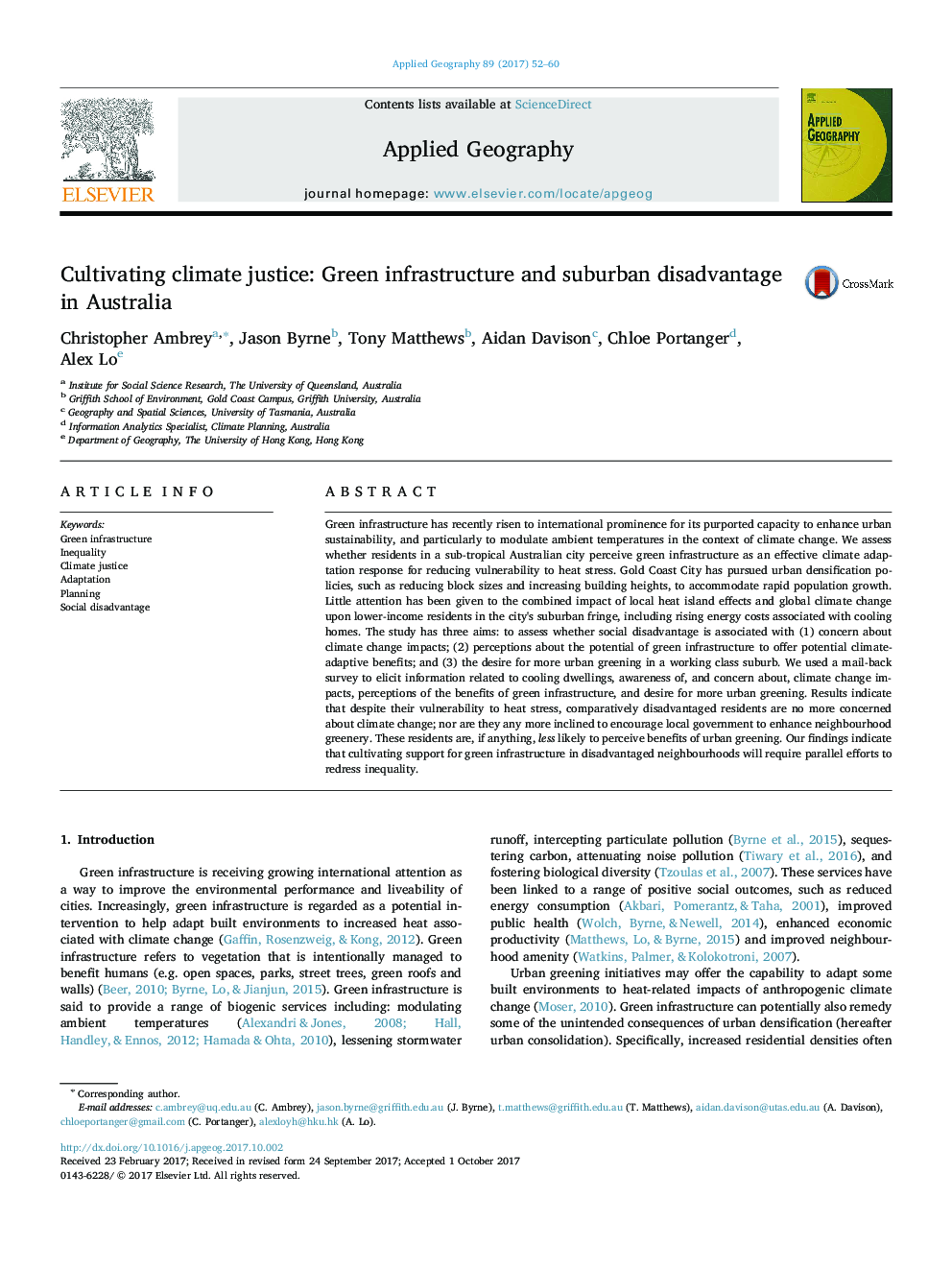| کد مقاله | کد نشریه | سال انتشار | مقاله انگلیسی | نسخه تمام متن |
|---|---|---|---|---|
| 4758995 | 1421028 | 2017 | 9 صفحه PDF | دانلود رایگان |
عنوان انگلیسی مقاله ISI
Cultivating climate justice: Green infrastructure and suburban disadvantage in Australia
ترجمه فارسی عنوان
پرورش عدالت محیط زیست: زیرساخت های سبز و زیان های حومه ای در استرالیا
دانلود مقاله + سفارش ترجمه
دانلود مقاله ISI انگلیسی
رایگان برای ایرانیان
کلمات کلیدی
زیرساخت سبز، نابرابری، عدالت محرمانه، انطباق، برنامه ریزی، ضرر اجتماعی،
ترجمه چکیده
زیرساخت سبز به تازگی به اهمیت بین المللی برای ظرفیت های مورد نظر خود برای افزایش پایداری شهری و به ویژه برای تغییر درجه حرارت محیط در شرایط تغییرات اقلیمی افزوده است. ما ارزیابی می کنیم که آیا ساکنین شهر استرالیا در زیر آب گرمسیری، زیرساخت های سبز را به عنوان یک پاسخ سازگار موثر برای سازگاری آب و هوا برای کاهش آسیب پذیری به استرس گرمایی می دانند. شهر طلای ساحل سیاست های تشدید شهری را دنبال می کند، مانند کاهش اندازه بلوک و افزایش ارتفاع ساختمان ها، به منظور رشد سریع جمعیت. توجه کمتری به اثرات ترکیبی جلسات گرمایی محلی و تغییرات اقلیمی جهانی بر ساکنان کم درآمد در حاشیه حومه شهر، از جمله افزایش هزینه های انرژی مرتبط با خانه های خنک کننده، داده شده است. این مطالعه دارای سه هدف است: ارزیابی اینکه آیا اختلال اجتماعی با (1) نگرانی در مورد اثرات تغییرات آب و هوایی مرتبط است؟ (2) ادراکات در مورد پتانسیل زیرساخت های سبز برای ارائه مزایای سازگاری بالقوه آب و هوا؛ و (3) تمایل به سبز سازی بیشتر شهری در حومه طبقه کارگر. ما برای بررسی اطلاعات مربوط به خانه های خنک کننده، آگاهی و نگرانی درباره تأثیرات تغییرات آب و هوایی، درک مزایای زیرساخت های سبز و تمایل به سبز سازی بیشتر شهری، از یک بررسی پست الکترونیکی استفاده کردیم. نتایج نشان می دهد که علیرغم آسیب پذیری آنها به استرس گرمایی، ساکنان نسبتا محروم، بیشتر نگران تغییر آب و هوا نیستند. آنها بیشتر مایل به تشویق دولت محلی برای افزایش سبز محله نیستند. این ساکنان، در صورت وجود هر چیزی، کمتر احتمال دارد که مزایای سبز سازی شهری را درک کنند. یافته های ما نشان می دهد که پشتیبانی کشت برای زیرساخت های سبز در محله های محروم نیاز به تلاش های موازی برای جبران نابرابری خواهد داشت.
موضوعات مرتبط
علوم زیستی و بیوفناوری
علوم کشاورزی و بیولوژیک
جنگلداری
چکیده انگلیسی
Green infrastructure has recently risen to international prominence for its purported capacity to enhance urban sustainability, and particularly to modulate ambient temperatures in the context of climate change. We assess whether residents in a sub-tropical Australian city perceive green infrastructure as an effective climate adaptation response for reducing vulnerability to heat stress. Gold Coast City has pursued urban densification policies, such as reducing block sizes and increasing building heights, to accommodate rapid population growth. Little attention has been given to the combined impact of local heat island effects and global climate change upon lower-income residents in the city's suburban fringe, including rising energy costs associated with cooling homes. The study has three aims: to assess whether social disadvantage is associated with (1) concern about climate change impacts; (2) perceptions about the potential of green infrastructure to offer potential climate-adaptive benefits; and (3) the desire for more urban greening in a working class suburb. We used a mail-back survey to elicit information related to cooling dwellings, awareness of, and concern about, climate change impacts, perceptions of the benefits of green infrastructure, and desire for more urban greening. Results indicate that despite their vulnerability to heat stress, comparatively disadvantaged residents are no more concerned about climate change; nor are they any more inclined to encourage local government to enhance neighbourhood greenery. These residents are, if anything, less likely to perceive benefits of urban greening. Our findings indicate that cultivating support for green infrastructure in disadvantaged neighbourhoods will require parallel efforts to redress inequality.
ناشر
Database: Elsevier - ScienceDirect (ساینس دایرکت)
Journal: Applied Geography - Volume 89, December 2017, Pages 52-60
Journal: Applied Geography - Volume 89, December 2017, Pages 52-60
نویسندگان
Christopher Ambrey, Jason Byrne, Tony Matthews, Aidan Davison, Chloe Portanger, Alex Lo,
